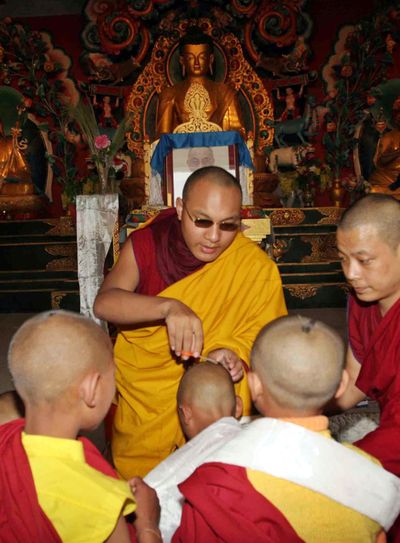The lama in waiting
Karmapa could be next leader of Tibetan Buddhists

SIDHBARI, India – Give the magnetic personality and hunky good looks of a rock star to a Tibetan Buddhist monk, and the result might be Gyalwang Karmapa, the third-highest lama in the Tibetan religious firmament.
The Karmapa, as he is known, is being talked about as a possible transition figure for when the Dalai Lama, who’s the spiritual leader of Tibetan Buddhists, dies.
The Dalai Lama, 73, was hospitalized last month to have gallstones removed.
At 23, the Karmapa is the first Tibetan Buddhist reincarnation to be recognized by both the Dalai Lama and Communist Party authorities of China.
He made headlines in January 2000, at age 14, with his flight from Chinese-ruled Tibet into exile, traveling by foot and horseback, then by jeep and helicopter to India.
Exuding self-assuredness, the solidly built, 6-foot-tall Karmapa received several foreign journalists in a rare interview last weekend at the university that’s his temporary home near the mountain headquarters of the Dalai Lama.
He sat cross-legged on a sofa in a large meeting room with Tibetan thangkas, or religious paintings, on the walls. Outside, crimson monks’ robes flapped from clotheslines in the warm sunshine, and crows cawed loudly from tree branches.
Some Tibetan exiles say the Karmapa has a magnetic hold on Tibetans.
“He’s young, he’s charismatic and he’s smart,” said Lobsang Sangay, a Tibetan exile who’s a senior fellow at Harvard Law School.
At meetings among hundreds of senior exiles in nearby Dharamsala last week, Sangay said the Karmapa’s name repeatedly emerged as a central figure in a post-Dalai Lama era.
“Some people like to say he’s going to take over the helm of the Tibetan movement when the Dalai Lama passes on,” said Phil Void, a musician and one-time Ph.D. candidate in Buddhism at Columbia University who lives in Dharamsala.
The Dalai Lama, asked about the Karmapa at a news conference Sunday, described him as “young, energetic and of course (with) a lot of experience in Tibet,” but declined to go further in elaborating on his future role.
The Karmapa is the head of the Karma Kagyu, one of four schools in Tibetan Buddhism. It is believed to have about a million followers in Tibet and several hundred thousand in Europe and the U.S.
He’s been called the 800-year-old lama. That’s because followers believe he’s the 17th in a line of consecutive lamas reincarnated, or born, with the same spirit or consciousness.
According to this belief, the current Karmapa embodies the collective wisdom and learning of all of his predecessors.
Using omens and a prediction note from the 16th Karmapa that turned up in an amulet, senior lamas identified a young boy, Ogyen Trinley Dorje, as the reincarnated Karmapa, and sent him for religious training at the Tsurphu Monastery near Lhasa, Tibet’s capital.
China gloried in its trophy lama, viewing him as a calming influence on restive Tibetans.
But the boy lama grew unhappy. He wasn’t allowed access to some of his teachers at Tsurphu Monastery, a vital lapse since many teachings are oral. So he doffed his robes and put on a baseball cap for a daring escape.
The flight into exile proved humiliating to China, which initially claimed that the Karmapa had gone to India to retrieve some musical instruments and key black hats worn by his Buddhist sect.
Once in India, the Karmapa found his movements constrained by Indian security agents who seemed to consider him a threat. He’s never been allowed to visit the Rumtek monastery in Sikkim that’s the seat of his sect in India.
Moreover, his sect has been riven by dispute. While the Dalai Lama has recognized him as the correct reincarnation, a sect leader tapped a rival as the real Karmapa, setting up his shop in New Delhi.
More recently, the Karmapa has been given a significantly looser leash by Indian security, visiting with U.S. followers last summer in New York, Boulder, Colo., and Seattle – a trip he called “wonderful,” adding: “I found some freedom.”
His residence in exile carries some sadness, too, as his parents remain in Tibet. China doesn’t permit them to travel to India.
“I want to see my parents,” he said. “Their life is very simple, in a remote place.”
So he devotes himself to intense religious study, preparing for the future, although he does enjoy a favorite pastime.
“I like music,” he said, but added: “I can’t dance because of these robes. I just listen.”